-
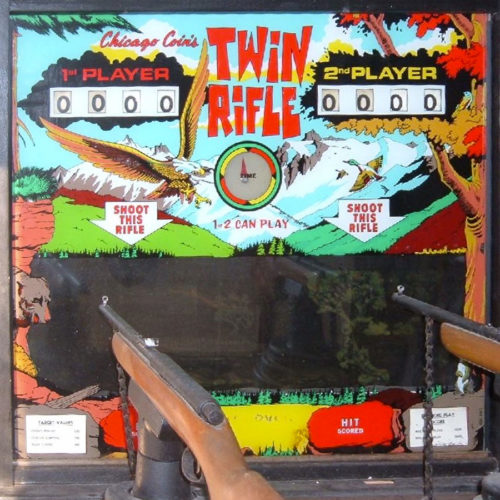
-
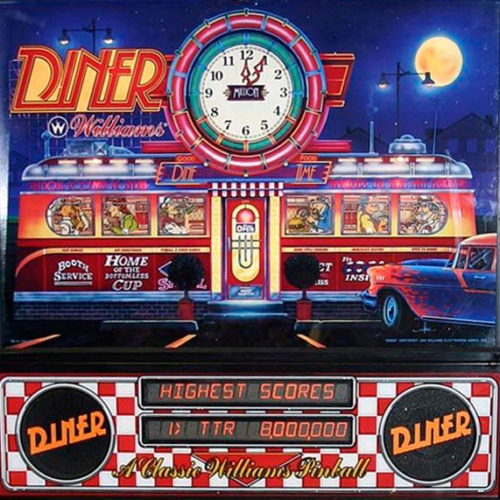
-
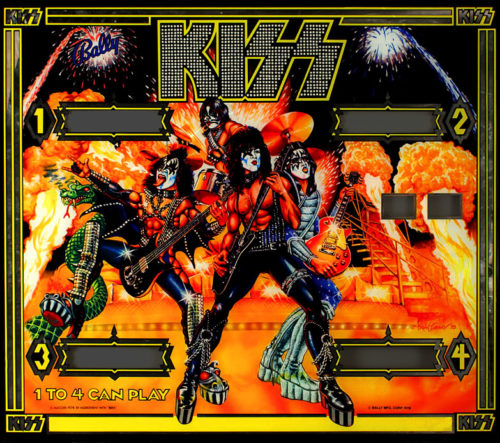 This very collectible game of the ‘70s was another in a series of celebrity-themed tie-in games Bally found license to produce. 17,000 units were made, a sizable number for the day. A prototype speaking version of this game was made ahead of its time but failed to be marketed. The object of the game is to spell out the name KISS. If you complete four times, a super bonus is awarded. Do it again and a colossal bonus is awarded. A third time awards a replay and a ton of points…which can be doubled if the 2x value drop targets are completed. The A, B, C, and D targets also can award extra balls and specials. The left drop targets award the KISS line when completed. All in all, an exciting game with great graphics but no speech. Talking pinballs finally made the scene with the release of Gorgar (in the museum). Replays are also awarded by score or matching. Matching is the process by which the last two numbers of your score match the generated number produced by the game.
This very collectible game of the ‘70s was another in a series of celebrity-themed tie-in games Bally found license to produce. 17,000 units were made, a sizable number for the day. A prototype speaking version of this game was made ahead of its time but failed to be marketed. The object of the game is to spell out the name KISS. If you complete four times, a super bonus is awarded. Do it again and a colossal bonus is awarded. A third time awards a replay and a ton of points…which can be doubled if the 2x value drop targets are completed. The A, B, C, and D targets also can award extra balls and specials. The left drop targets award the KISS line when completed. All in all, an exciting game with great graphics but no speech. Talking pinballs finally made the scene with the release of Gorgar (in the museum). Replays are also awarded by score or matching. Matching is the process by which the last two numbers of your score match the generated number produced by the game. -
-
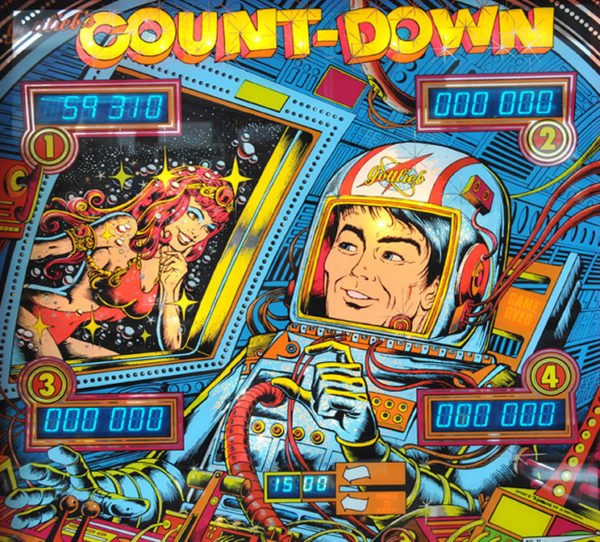
-
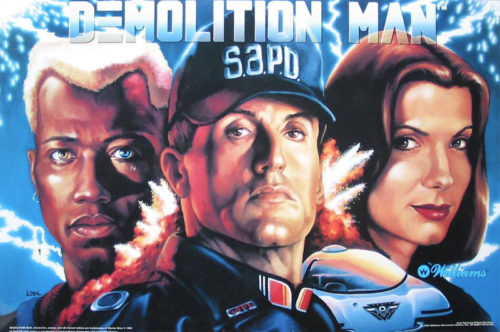 Demolition Man is a Williams pinball machine released in February 1994. It is based on the motion picture of the same name. It is part of WMS’ SuperPin line of widebody games. Sylvester Stallone (John Spartan) and Wesley Snipes (Simon Phoenix) provided custom speech for this game during ADR sessions at Warner Brothers Studios in Los Angeles under the direction of Jon Hey. Hey scored the music of the pinball game in part based upon the movie score by Academy Award winner Elliot Goldenthal, but including new music. Multiball modes This game is centered on multiball modes. The player has to shoot the left ramp when the “freeze” light is lit (lit by the right inlane) to “lock” a ball. When the required amount of locks are made, the player has to shoot the left loop to start multiball. Fortress Multiball (2 balls required) – A normal multiball mode with 3 jackpots and the “Super Jackpot”. 1-4 balls can be shot up. Museum Multiball (3 balls required) – Jackpots everywhere, except the standups. After the “Super Jackpot” the Multiball starts over. 3-6 balls can be shot up. Wasteland Multiball (4 balls required) – Same as “Fortress Multiball”. If not getting the lighting jackpots, the next jackpot will appear and the previous jackpot will stay. 4-8 balls can be shot up. Cryoprison Multiball (5 balls required) – The “Super Jackpot” is lit, from the beginning of the multiball. After getting the “Super Jackpot” it will lit again after hitting an arrow or more. Completing all four multiball modes lights the right ramp for the wizard award, Demolition Jackpot, which is the total amount of all the jackpots collected during the game. The Demolition Jackpot is lost if the ball drains. If you hit all jackpots in a multiball, the “Super Jackpot” light will lit. Getting the ball up to the “Cryo-Claw” whilst, you will get it. The “Super Jackpot” light turns off, if all the balls drain and the Multiball is over, the “Super Jackpot” is lost.
Demolition Man is a Williams pinball machine released in February 1994. It is based on the motion picture of the same name. It is part of WMS’ SuperPin line of widebody games. Sylvester Stallone (John Spartan) and Wesley Snipes (Simon Phoenix) provided custom speech for this game during ADR sessions at Warner Brothers Studios in Los Angeles under the direction of Jon Hey. Hey scored the music of the pinball game in part based upon the movie score by Academy Award winner Elliot Goldenthal, but including new music. Multiball modes This game is centered on multiball modes. The player has to shoot the left ramp when the “freeze” light is lit (lit by the right inlane) to “lock” a ball. When the required amount of locks are made, the player has to shoot the left loop to start multiball. Fortress Multiball (2 balls required) – A normal multiball mode with 3 jackpots and the “Super Jackpot”. 1-4 balls can be shot up. Museum Multiball (3 balls required) – Jackpots everywhere, except the standups. After the “Super Jackpot” the Multiball starts over. 3-6 balls can be shot up. Wasteland Multiball (4 balls required) – Same as “Fortress Multiball”. If not getting the lighting jackpots, the next jackpot will appear and the previous jackpot will stay. 4-8 balls can be shot up. Cryoprison Multiball (5 balls required) – The “Super Jackpot” is lit, from the beginning of the multiball. After getting the “Super Jackpot” it will lit again after hitting an arrow or more. Completing all four multiball modes lights the right ramp for the wizard award, Demolition Jackpot, which is the total amount of all the jackpots collected during the game. The Demolition Jackpot is lost if the ball drains. If you hit all jackpots in a multiball, the “Super Jackpot” light will lit. Getting the ball up to the “Cryo-Claw” whilst, you will get it. The “Super Jackpot” light turns off, if all the balls drain and the Multiball is over, the “Super Jackpot” is lost. -

-

-
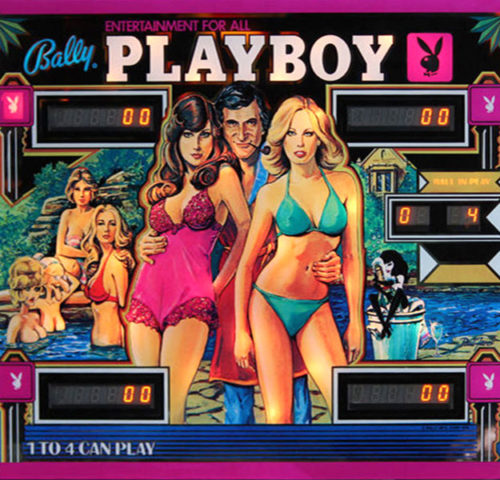 This solid-state game was very popular when it was released and has a lot of smooth shots to complete. It was designed by Jim Patla with artwork by Paul Faris. Production run was 18,250 units. This pre-speaking pinball has Hugh Hefner on its backglass with Bunny Sondra Theodore posing. At the top of the game are four rollover lanes, which advance when hit to a special and advance the bonuses and grotto award. Hitting the five Bunny targets also advance a feature to win extra balls and specials. A unique kickback lane advances with every entrance into it. A five-pack of drop targets also advance certain features on the game. If 20,000 points are made on the bonus system, this point count is carried over to all remaining balls and then some. The nicest shot on the game is going up the right side from the flipper and looping the ball into the grotto. The sound originates from the old TV show “Playboy After Dark.”
This solid-state game was very popular when it was released and has a lot of smooth shots to complete. It was designed by Jim Patla with artwork by Paul Faris. Production run was 18,250 units. This pre-speaking pinball has Hugh Hefner on its backglass with Bunny Sondra Theodore posing. At the top of the game are four rollover lanes, which advance when hit to a special and advance the bonuses and grotto award. Hitting the five Bunny targets also advance a feature to win extra balls and specials. A unique kickback lane advances with every entrance into it. A five-pack of drop targets also advance certain features on the game. If 20,000 points are made on the bonus system, this point count is carried over to all remaining balls and then some. The nicest shot on the game is going up the right side from the flipper and looping the ball into the grotto. The sound originates from the old TV show “Playboy After Dark.” -
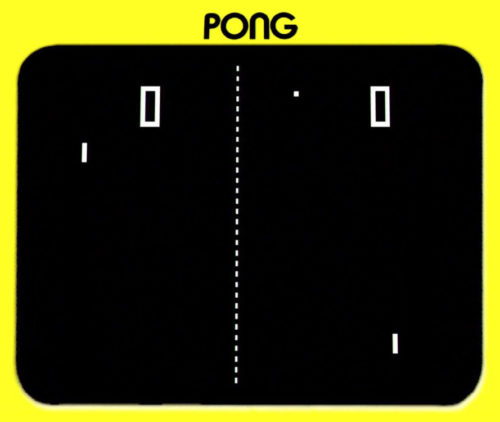 Atari PONG was released in June 1972 and is the first commercially successful video game and is based on a simple two-dimensional graphical representation of a tennis-like game. Players use paddles to hit a ball back and forth on a black and white screen. Pong was the first game developed by Atari Inc., by Nolan Bushnell and Ted Dabney. Pong (marketed as PONG) is one of the earliest arcade video games, and is a tennis sports game featuring simple two-dimensional graphics. The player controls an in-game paddle by moving it vertically across the left side of the screen, and can compete against either a computer controlled opponent or another player controlling a second paddle on the opposing side. Players use the paddles to hit a ball back and forth. The aim is for a player to earn more points than the opponent; points are earned when one fails to return the ball to the other. Pong consistently earned four times more revenue than other coin-operated machines, which resulted in an increase in the number of orders Atari received. This provided Atari with a steady source of income; the company sold the machines at three times the cost of production. By 1973, the company had filled 2,500 orders, and, at the end of 1974, sold more than 8,000 units.[20] The arcade cabinets have since become collector’s items with the cocktail-table version being the rarest. Atari eventually sold more than 35,000 units, however, many more imitations were produced by competitors.
Atari PONG was released in June 1972 and is the first commercially successful video game and is based on a simple two-dimensional graphical representation of a tennis-like game. Players use paddles to hit a ball back and forth on a black and white screen. Pong was the first game developed by Atari Inc., by Nolan Bushnell and Ted Dabney. Pong (marketed as PONG) is one of the earliest arcade video games, and is a tennis sports game featuring simple two-dimensional graphics. The player controls an in-game paddle by moving it vertically across the left side of the screen, and can compete against either a computer controlled opponent or another player controlling a second paddle on the opposing side. Players use the paddles to hit a ball back and forth. The aim is for a player to earn more points than the opponent; points are earned when one fails to return the ball to the other. Pong consistently earned four times more revenue than other coin-operated machines, which resulted in an increase in the number of orders Atari received. This provided Atari with a steady source of income; the company sold the machines at three times the cost of production. By 1973, the company had filled 2,500 orders, and, at the end of 1974, sold more than 8,000 units.[20] The arcade cabinets have since become collector’s items with the cocktail-table version being the rarest. Atari eventually sold more than 35,000 units, however, many more imitations were produced by competitors. -
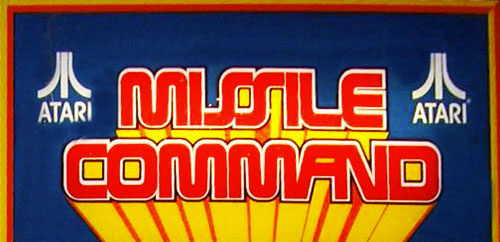 Missile Command is a 1980 arcade game by Atari, Inc. that was also licensed to Sega for European release. It is considered one of the most notable games from the Golden Age of Video Arcade Games. The plot of Missile Command is simple: the player’s six cities are being attacked by an endless hail of ballistic missiles, some of them even splitting like multiple independently targetable reentry vehicles (MIRVs), and in later levels smart bombs which can evade a less than perfectly targeted missile. As a regional commander of three anti-missile batteries, the player must defend six cities in their zone from being destroyed. The game is played by moving a crosshair across the sky background via a trackball and pressing one of three buttons to launch a counter-missile from the appropriate battery. Counter-missiles explode upon reaching the crosshair, leaving a fireball that persists for several seconds and destroys any enemy missiles that enter it. There are three batteries, each with ten missiles; a missile battery becomes useless when all its missiles are fired, or if the battery is destroyed by enemy fire. The missiles of the central battery fly to their targets at much greater speed; only these missiles can effectively kill a smart bomb at a distance. The game is staged as a series of levels of increasing difficulty; each level contains a set number of incoming enemy weapons. The weapons attack the six cities, as well as the missile batteries; being struck by an enemy weapon results in destruction of the city or missile battery. Enemy weapons are only able to destroy 3 cities during one level. A level ends if all the cities are destroyed, or when all enemy weaponry is destroyed or reaches its target. A player who runs out of missiles no longer has control over the remainder of the level. At the conclusion of a level, the player receives bonus points for any remaining cities or unused missiles. Between levels missile batteries are rebuilt and replenished; destroyed cities are rebuilt only at set point levels (usually 10 or 12K). The game inevitably ends when all six cities have been wiped out. Like most early arcade games, there is no way to “win” the game; the game just keeps going with ever faster and more prolific incoming missiles. The game, then, is just a contest in seeing how long the player can survive. On conclusion of the game, the screen displays “The End”, perhaps a poke at oncoming Nuclear Holocaust rather than the standard “Game Over” text (however, if the player is able to make the high score list, the game then prompts the player to enter his/her initials, with the “The End” sequence skipped). The game features an interesting bug: once a score of 810,000 is reached, a large number of cities are awarded (176 cities plus the continuing accrual of bonus cities) and it is possible to carry on playing for several hours. At some later stage the speed of missiles increases greatly for a few screens. On the 255th and 256th yellow screens, known as the 0x stages, the scoring increases by 256 times the base value. For good players these two 0x stages could earn over a million points. This enabled them to reach a score of approximately 2,800,000 (although only 6 digit scores were shown, so it would display 800,000) and at this point the accelerated rate would suddenly cease and the game would restart at its original (slow) speed and return to the first stage, but with the score and any saved cities retained. In this way it was possible to play this game for hours on end. Targeting crosshair: Aim your missiles quickly but carefully. Use the trackball to move the targeting crosshair to where you want the next missile to go, then press any Launch Control button to fire the missile. The missile will explode where the crosshair was positioned when the Launch Control button was pressed. Cities: There are six cities in total on the screen at one time, three on either side of the Delta Base. If one enemy missile or Smart Bomb manages to strike a city, that city will be wiped out. When all cities are destroyed, the game is over. Alpha Base: The missile base on the left side of the screen. Press the leftmost Launch Control button to launch an ABM from the Alpha Base. Delta Base: The missile base in the center of the screen. Press the middle Launch Control button to launch an ABM from the Delta Base. Omega Base: The missile base on the right side of the screen. Press the rightmost Launch Control button to launch an ABM from the Omega Base. NOTE: The Alpha and Omega Bases launch ABMs at a slower speed than the Delta Base, so you must plan further ahead when launching missiles from those bases. Defensive Missiles : The ABMs you launch to protect your cities. Each missile base contains 10 ABMs per wave. If any missile base is struck by an attack missile or smart bomb, the remaining stock of missiles for that wave are destroyed, and the missile base is rendered useless until the next wave. You receive bonus points for every ABM you have remaining at the end of each wave. Attack Missiles : Their only aim is to destroy your cities and missile bases. Every missile wave starts off with a hailstorm of attack missiles. They never deviate from their path. They may, however, turn into MIRVs. MIRV : Surprise! There is no warning when an attack missile turns into an MIRV (with multiple warheads). Think fast. Each new missile that the MIRV unleashes is carefully targeted. Killer Satellite: A mean-looking satellite that travels across the sky at a mid-level altitude and fires attack missiles. First appears in Wave 2. Bomber: A big slow-moving target that flies across the sky at a mid-level altitude, but watch out! It fires attack missiles. First appears in Wave 2. WARNING: If you destory a bomber or killer satellite before they deploy their missiles, you may see their missiles added to the downpour. An existing missile may also turn into an MIRV. Smart Bomb: Smart enough to avoid most explosion clouds from your ABMs. Your ABM must explode next to one in order to destroy it. You can also squeen it between two explosions to destroy it. First appears in Wave 5. ‘LOW’ Warning: As soon as there are only three ABMs left in a missile base, the game displays the word “LOW” underneath that base, and a warning signal sounds. Heed the warning.
Missile Command is a 1980 arcade game by Atari, Inc. that was also licensed to Sega for European release. It is considered one of the most notable games from the Golden Age of Video Arcade Games. The plot of Missile Command is simple: the player’s six cities are being attacked by an endless hail of ballistic missiles, some of them even splitting like multiple independently targetable reentry vehicles (MIRVs), and in later levels smart bombs which can evade a less than perfectly targeted missile. As a regional commander of three anti-missile batteries, the player must defend six cities in their zone from being destroyed. The game is played by moving a crosshair across the sky background via a trackball and pressing one of three buttons to launch a counter-missile from the appropriate battery. Counter-missiles explode upon reaching the crosshair, leaving a fireball that persists for several seconds and destroys any enemy missiles that enter it. There are three batteries, each with ten missiles; a missile battery becomes useless when all its missiles are fired, or if the battery is destroyed by enemy fire. The missiles of the central battery fly to their targets at much greater speed; only these missiles can effectively kill a smart bomb at a distance. The game is staged as a series of levels of increasing difficulty; each level contains a set number of incoming enemy weapons. The weapons attack the six cities, as well as the missile batteries; being struck by an enemy weapon results in destruction of the city or missile battery. Enemy weapons are only able to destroy 3 cities during one level. A level ends if all the cities are destroyed, or when all enemy weaponry is destroyed or reaches its target. A player who runs out of missiles no longer has control over the remainder of the level. At the conclusion of a level, the player receives bonus points for any remaining cities or unused missiles. Between levels missile batteries are rebuilt and replenished; destroyed cities are rebuilt only at set point levels (usually 10 or 12K). The game inevitably ends when all six cities have been wiped out. Like most early arcade games, there is no way to “win” the game; the game just keeps going with ever faster and more prolific incoming missiles. The game, then, is just a contest in seeing how long the player can survive. On conclusion of the game, the screen displays “The End”, perhaps a poke at oncoming Nuclear Holocaust rather than the standard “Game Over” text (however, if the player is able to make the high score list, the game then prompts the player to enter his/her initials, with the “The End” sequence skipped). The game features an interesting bug: once a score of 810,000 is reached, a large number of cities are awarded (176 cities plus the continuing accrual of bonus cities) and it is possible to carry on playing for several hours. At some later stage the speed of missiles increases greatly for a few screens. On the 255th and 256th yellow screens, known as the 0x stages, the scoring increases by 256 times the base value. For good players these two 0x stages could earn over a million points. This enabled them to reach a score of approximately 2,800,000 (although only 6 digit scores were shown, so it would display 800,000) and at this point the accelerated rate would suddenly cease and the game would restart at its original (slow) speed and return to the first stage, but with the score and any saved cities retained. In this way it was possible to play this game for hours on end. Targeting crosshair: Aim your missiles quickly but carefully. Use the trackball to move the targeting crosshair to where you want the next missile to go, then press any Launch Control button to fire the missile. The missile will explode where the crosshair was positioned when the Launch Control button was pressed. Cities: There are six cities in total on the screen at one time, three on either side of the Delta Base. If one enemy missile or Smart Bomb manages to strike a city, that city will be wiped out. When all cities are destroyed, the game is over. Alpha Base: The missile base on the left side of the screen. Press the leftmost Launch Control button to launch an ABM from the Alpha Base. Delta Base: The missile base in the center of the screen. Press the middle Launch Control button to launch an ABM from the Delta Base. Omega Base: The missile base on the right side of the screen. Press the rightmost Launch Control button to launch an ABM from the Omega Base. NOTE: The Alpha and Omega Bases launch ABMs at a slower speed than the Delta Base, so you must plan further ahead when launching missiles from those bases. Defensive Missiles : The ABMs you launch to protect your cities. Each missile base contains 10 ABMs per wave. If any missile base is struck by an attack missile or smart bomb, the remaining stock of missiles for that wave are destroyed, and the missile base is rendered useless until the next wave. You receive bonus points for every ABM you have remaining at the end of each wave. Attack Missiles : Their only aim is to destroy your cities and missile bases. Every missile wave starts off with a hailstorm of attack missiles. They never deviate from their path. They may, however, turn into MIRVs. MIRV : Surprise! There is no warning when an attack missile turns into an MIRV (with multiple warheads). Think fast. Each new missile that the MIRV unleashes is carefully targeted. Killer Satellite: A mean-looking satellite that travels across the sky at a mid-level altitude and fires attack missiles. First appears in Wave 2. Bomber: A big slow-moving target that flies across the sky at a mid-level altitude, but watch out! It fires attack missiles. First appears in Wave 2. WARNING: If you destory a bomber or killer satellite before they deploy their missiles, you may see their missiles added to the downpour. An existing missile may also turn into an MIRV. Smart Bomb: Smart enough to avoid most explosion clouds from your ABMs. Your ABM must explode next to one in order to destroy it. You can also squeen it between two explosions to destroy it. First appears in Wave 5. ‘LOW’ Warning: As soon as there are only three ABMs left in a missile base, the game displays the word “LOW” underneath that base, and a warning signal sounds. Heed the warning. -
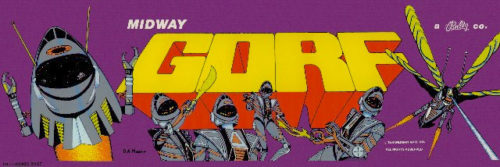 Gorf is an arcade game released in 1981 by Midway Mfg., whose name was advertised as an acronym for “Galactic Orbiting Robot Force”. It is a multiple-mission fixed shooter with five distinct modes of play, essentially making it five games in one. It is well known for its use of synthesized speech, a new feature at the time. The player controls a spaceship that can move left, right, up and down around the lower third of the screen. The ship can fire a single shot (called a “quark laser” in this game), which travels vertically up the screen. Unlike similar games, where the player cannot fire again until his existing shot has disappeared, the player can choose to fire another shot at any time; if the previous shot is still on screen, it disappears. Gorf consists of five distinct “missions”, each with its own patterns of enemies. The central goal of each mission is to destroy all enemies in that wave, which takes the player to the next mission. Successfully completing all five missions will increase the player’s rank and loop back to the first mission, where play continues on a higher difficulty level. The game continues until the player loses all their lives. The player can advance through the ranks of Space Cadet, Space Captain, Space Colonel, Space General, Space Warrior, and Space Avenger, with a higher difficulty level at each rank. Along the way, a robotic voice heckles and threatens the player, often calling the player by his current rank (for example, “Some galactic defender you are, Space Cadet!”). Some versions also display the player’s current rank via a series of lit panels in the cabinet. The missions are: 1.Astro Battles: The first mission is almost an exact clone of Space Invaders. This is the only mission that is not set in space, but rather against a sky-blue background. A small force of enemies (24 in Gorf vs. 55 in Space Invaders) attacks in the classic pattern set by the original game. The player is protected by a glittering parabolic force field that is gradually worn away by enemy fire. The force field switches off temporarily while the player’s shots pass through it. 2.Laser Attack: In this mission, the player must battle two formations of five enemies each. Each formation contains three yellow enemies that attempt to dive-bomb the player, a white gun that fires a single laser beam, and a red miniature version of the Gorf robot. 3.Galaxians: This mission is a clone of Galaxian, with the key differences being the number of enemies (24 in Gorf vs. 46 in Galaxian) and the way the enemies fire (pellets in Gorf, missiles in Galaxian). Gameplay is otherwise similar to the original game. 4.Space Warp: Mission 4 places the player in a sort of wormhole, where enemies fly outward from the center of the screen and attempt to either shoot down or collide with the player’s ship. It is possible to shoot enemy shots in this level. 5.Flag Ship: The Flag Ship is protected by its own force field (similar to the one protecting the player in Mission 1), and it flies back and forth and fires at the player. To defeat it, the player must break through the force field and destroy the ship’s core: if a different part of the ship is hit the player receives bonus points and the part breaks off and flies in a random direction, potentially posing a risk to the player’s ship. If the player successful hits the Flag Ship’s core, the Flag Ship explodes in a dramatic display, the player advances to the next rank, and play continues on Mission 1, with the difficulty increased.
Gorf is an arcade game released in 1981 by Midway Mfg., whose name was advertised as an acronym for “Galactic Orbiting Robot Force”. It is a multiple-mission fixed shooter with five distinct modes of play, essentially making it five games in one. It is well known for its use of synthesized speech, a new feature at the time. The player controls a spaceship that can move left, right, up and down around the lower third of the screen. The ship can fire a single shot (called a “quark laser” in this game), which travels vertically up the screen. Unlike similar games, where the player cannot fire again until his existing shot has disappeared, the player can choose to fire another shot at any time; if the previous shot is still on screen, it disappears. Gorf consists of five distinct “missions”, each with its own patterns of enemies. The central goal of each mission is to destroy all enemies in that wave, which takes the player to the next mission. Successfully completing all five missions will increase the player’s rank and loop back to the first mission, where play continues on a higher difficulty level. The game continues until the player loses all their lives. The player can advance through the ranks of Space Cadet, Space Captain, Space Colonel, Space General, Space Warrior, and Space Avenger, with a higher difficulty level at each rank. Along the way, a robotic voice heckles and threatens the player, often calling the player by his current rank (for example, “Some galactic defender you are, Space Cadet!”). Some versions also display the player’s current rank via a series of lit panels in the cabinet. The missions are: 1.Astro Battles: The first mission is almost an exact clone of Space Invaders. This is the only mission that is not set in space, but rather against a sky-blue background. A small force of enemies (24 in Gorf vs. 55 in Space Invaders) attacks in the classic pattern set by the original game. The player is protected by a glittering parabolic force field that is gradually worn away by enemy fire. The force field switches off temporarily while the player’s shots pass through it. 2.Laser Attack: In this mission, the player must battle two formations of five enemies each. Each formation contains three yellow enemies that attempt to dive-bomb the player, a white gun that fires a single laser beam, and a red miniature version of the Gorf robot. 3.Galaxians: This mission is a clone of Galaxian, with the key differences being the number of enemies (24 in Gorf vs. 46 in Galaxian) and the way the enemies fire (pellets in Gorf, missiles in Galaxian). Gameplay is otherwise similar to the original game. 4.Space Warp: Mission 4 places the player in a sort of wormhole, where enemies fly outward from the center of the screen and attempt to either shoot down or collide with the player’s ship. It is possible to shoot enemy shots in this level. 5.Flag Ship: The Flag Ship is protected by its own force field (similar to the one protecting the player in Mission 1), and it flies back and forth and fires at the player. To defeat it, the player must break through the force field and destroy the ship’s core: if a different part of the ship is hit the player receives bonus points and the part breaks off and flies in a random direction, potentially posing a risk to the player’s ship. If the player successful hits the Flag Ship’s core, the Flag Ship explodes in a dramatic display, the player advances to the next rank, and play continues on Mission 1, with the difficulty increased.